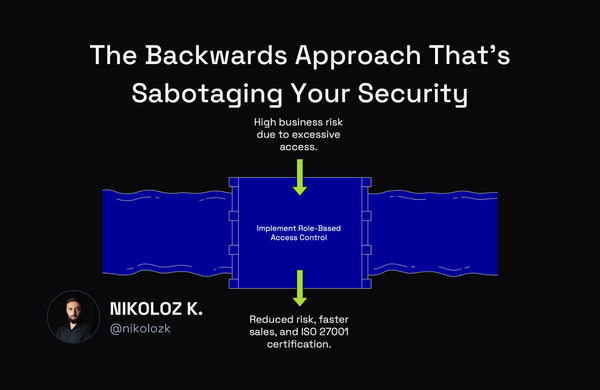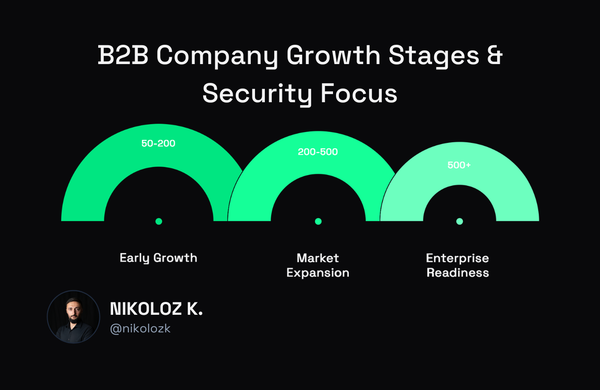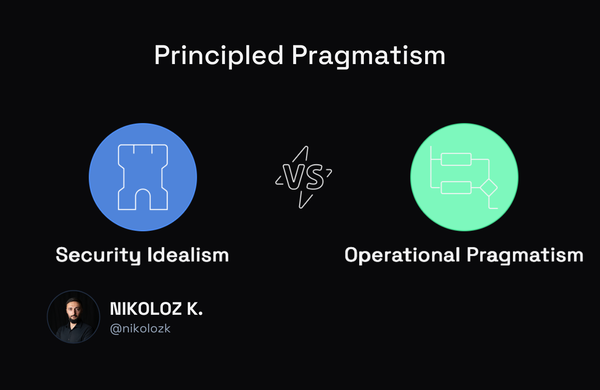Define Cybersecurity Initiatives That Align with Business Goals

Nikoloz Kokhreidze
Explore key methodologies for aligning cybersecurity initiatives with business goals. Discover actionable steps and examples to identify business drivers.

Have you ever led a security initiative only to discover it’s steering away from your business's core objectives?
Many security leaders fail during implementation of security initiatives. In a rush to innovate and address new threats, they will buy the tools and spend FTE hours on deployment. Only to realize that the solution does not align with the strategic business goals. This disconnect creates extra liabilities for security teams. Additionally, it leaves CISOs struggling to justify the budget spend. As a result, business concerns remain unaddressed.
Root cause? Not identifying the business objectives before jumping into solutions.
To bridge this gap, let’s explore a methodology that ensures alignment with strategic business objectives.
In this article, I will share the steps to help you identify business drivers for cybersecurity initiatives. You will learn where to seek those with scenarios, examples and checklists. As a result you can become a trusted business partner for your organization.
Review Strategic Plan
Start from the top. Your organization's strategic plan provides valuable insights into its direction.
Analyze the plan to identify key business objectives that can be supported by security initiatives.
Scenario: Per strategic plan brick-and-mortar retailer is transitioning to e-commerce. An e-commerce platform needs secure transactions and strong cybersecurity measures.
Business Driver: Digital transformation & innovation.
Security Initiative: Encrypted transactions for e-commerce platform.
Actions to Take:
- Schedule a bi-annual strategic review meeting with the leadership team.
- Create a matrix to map key business objectives against security initiatives.
- Identify and document how each security initiative supports a specific business goal.
Hold Stakeholder Meeting
Engaging with other leaders is essential for understanding the business context.
Schedule regular catchups to gain insights and build relationships across the organization. Strong relationships foster trust, and trust leads to success.
Scenario: Engineering department is working on a proprietary algorithm for automating sales operations. If the algorithm gets exposed, competitors will take advantage of it and R&D investments will be lost.
Business Driver: Intellectual property protection.
Security Initiative: Data leakage prevention for the engineering team.
Actions to Take:
- Establish a recurring monthly security roundtable with department heads.
- Develop a dashboard to track the progress of security initiatives against business drivers.
- Create a protocol for rapid response and communication when new security needs arise from these meetings.
Customer Interactions
Your customers can be a goldmine for identifying pain points and growth opportunities.
Review customer feedback, queries, and complaints related to security and compliance. Patterns may emerge, helping you pinpoint critical business drivers.
Scenario: Customers of a cloud service provider need to adhere to the new regulation. The regulation requires them to control encryption keys. If customers do not follow the regulation, they might lose a license to operate.
Business Driver: Customer demand & expectations.
Security Initiative: Develop a bring-your-own-key encryption feature.
Actions to Take:
- Set up a monthly review process of customer service logs for security-related issues.
- Integrate a feedback loop into your product/service delivery platforms. Gather customer security insights in real time.
- Designate a team to analyze customer feedback and propose security enhancements to the product team.
Regulatory Landscape
As threats and cybersecurity risks evolve, so do regulations, albeit at a slower pace.
Keep an eye on new or changing regulations that might require security adjustments. By doing so you will avert risks of compliance issues and hefty fines.
Scenario: The European arm of your organization is preparing for DORA compliance. It requires having regular security tests for your organization.
Business Driver: Regulatory compliance.
Security Initiative: Engage Managed Security Service Provider (MSSP) to provide regular penetration testing services.
Actions to Take:
- Assign a compliance officer to monitor regulatory requirements and report back to the team quarterly.
- Implement a compliance tracking system to ensure timely updates to security policies.
- Conduct a semi-annual 'regulatory impact' analysis to assess the implications of upcoming regulations.
Is Security Blocking Your Next Enterprise Deal?
Let's discuss how fractional CISO services can unlock your pipeline without the full-time overhead.
Competitor Analysis
Competitors might introduce security measures giving them a business advantage over your organization.
Observe what security measures competitors are implementing. This could indicate their customer expectations or new ways for achieving security-driven growth.
Scenario: A competitor in online collaboration business is rolling out encrypted video calls. This enables customer teams to safely collaborate on sensitive projects. Enterprise customers will be more interested in engaging with a competitor.
Business Driver: Revenue protection & growth.
Security Initiative: Work with engineering teams to design encrypted video calls and messaging feature.
Actions to Take:
- Use a competitive intelligence platform to track and report on competitors’ security offerings.
- Develop a feature comparison chart to check how your security measures stack up against competitors.
- Start a quarterly review process to adjust your security strategy based on competitive movements.
Internal Data Analysis
Data is the king. Use data analytics to discover areas of frequent security incidents or automation opportunities.
Identify and prioritize risks based on their impact on business operations.
Scenario: A manufacturer has noticed uptick in quarantined malware on their OT environment. If the future attacks are successful, they might need to halt operations. Downtime of a few hours can lead to millions in financial losses. (See example for Clorox).
Business Driver: Operational continuity.
Security Initiative: OT network segmentation and anti-ransomware solution deployment.
Actions to Take:
- Deploy a security information and event management (SIEM) system to automate data analysis.
- Set up real-time alerts for abnormal patterns that could indicate security threats.
- Perform a quarterly risk assessment to determine the impact of incidents on business operations.
Feedback from Frontline Teams
Frontline teams, including IT, sales, and customer service, often understand security needs and operational issues.
Listening to their feedback can help identify essential business drivers.
Scenario: Employees have been contacting IT about forgotten passwords. This results in operational overhead for IT support and loss of access for business.
Business Driver: Business continuity
Security Initiative: Install a central password management solution allowing employees to secure store passwords. Employees will have to remember a single password instead of many.
Actions to Take:
- Implement a frontline feedback tool for immediate reporting of security concerns or suggestions.
- Organize a monthly 'security insights' workshop with IT, sales, and customer service teams to discuss new threats and ideas.
- Establish a process for translating frontline feedback into security policy updates or initiatives.
Conclusion
Successful cybersecurity initiatives are those that align with your business objectives. By following the proactive steps, you can transition from a mere defender against threats to a strategic business enabler and define business-driven initiatives. Reflect on these strategies, identify your business drivers, and take action. Doing so will ensure your efforts contribute to the overarching goals and growth of your organization.
Long read for this week, let's see what the next one brings.
P.S.: If this content resonates with you, consider following me on LinkedIn and X.
Nikoloz



